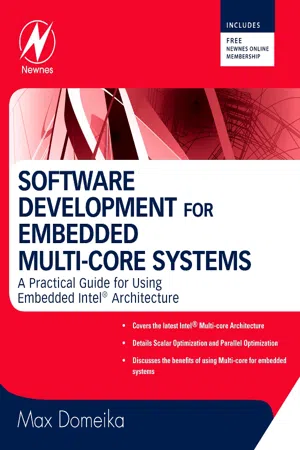
Software Development for Embedded Multi-core Systems
A Practical Guide Using Embedded Intel Architecture
- 440 pages
- English
- PDF
- Available on iOS & Android
Software Development for Embedded Multi-core Systems
A Practical Guide Using Embedded Intel Architecture
About This Book
The multicore revolution has reached the deployment stage in embedded systems ranging from small ultramobile devices to large telecommunication servers. The transition from single to multicore processors, motivated by the need to increase performance while conserving power, has placed great responsibility on the shoulders of software engineers. In this new embedded multicore era, the toughest task is the development of code to support more sophisticated systems. This book provides embedded engineers with solid grounding in the skills required to develop software targeting multicore processors. Within the text, the author undertakes an in-depth exploration of performance analysis, and a close-up look at the tools of the trade. Both general multicore design principles and processor-specific optimization techniques are revealed. Detailed coverage of critical issues for multicore employment within embedded systems is provided, including the Threading Development Cycle, with discussions of analysis, design, development, debugging, and performance tuning of threaded applications. Software development techniques engendering optimal mobility and energy efficiency are highlighted through multiple case studies, which provide practical "how-to" advice on implementing the latest multicore processors. Finally, future trends are discussed, including terascale, speculative multithreading, transactional memory, interconnects, and the software-specific implications of these looming architectural developments.
- This is the only book to explain software optimization for embedded multi-core systems
- Helpful tips, tricks and design secrets from an Intel programming expert, with detailed examples using the popular X86 architecture
- Covers hot topics, including ultramobile devices, low-power designs, Pthreads vs. OpenMP, and heterogeneous cores
Frequently asked questions
Information
Table of contents
- Front Cover
- Software Development for Embedded Multi-core Systems: A Practical Guide Using Embedded Intel® Architecture
- Copyright Page
- Contents
- Preface
- Acknowledgments
- Chapter 1: Introduction
- Chapter 2: Basic System and Processor Architecture
- Chapter 3: Multi-core Processors and Embedded
- Chapter 4: Moving to Multi-core Intel Architecture
- Chapter 5: Scalar Optimization and Usability
- Chapter 6: Parallel Optimization Using Threads
- Chapter 7: Case Study: Data Decomposition
- Chapter 8: Case Study: Functional Decomposition
- Chapter 9: Virtualization and Partitioning
- Chapter 10: Getting Ready for Low Power Intel Architecture
- Chapter 11: Summary, Trends, and Conclusions
- Appendix A
- Glossary
- Index